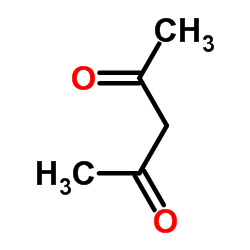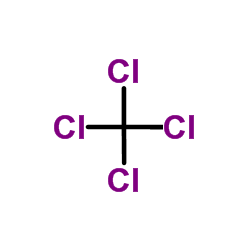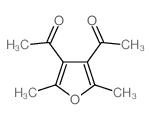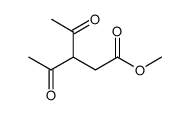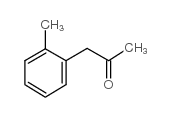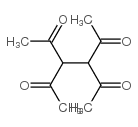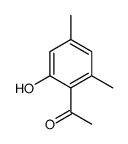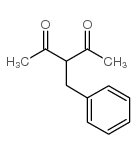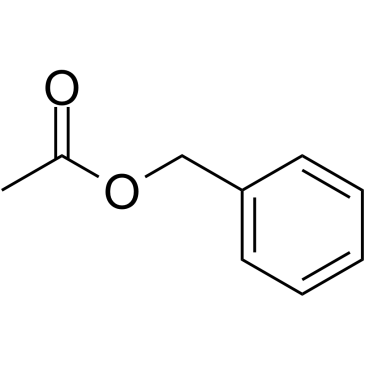15435-71-9
| Name | Sodium acetylacetonate hydrate |
|---|---|
| Synonyms |
sodium acetoxyacetate
acetylacetone sodium salt Sodium (2Z)-4-oxo-2-penten-2-olate hydrate (1:1:1) EINECS 239-448-9 sodium 1,3-pentanedionate SODIUM ACETOACETATE 3-Penten-2-one, 4-hydroxy-, sodium salt, (3Z)-, hydrate (1:1:1) Butanoic acid,3-oxo-,sodium salt acetoacetic acid,monosodium salt sodium acetoacetic acid ester sodium acetylacetonate sodium acetylacetone enolate sodium 3-oxobutanoate sodium salt of acetylacetone |
| Molecular Formula | C5H9NaO3 |
|---|---|
| Molecular Weight | 140.113 |
| Exact Mass | 140.044937 |
| PSA | 40.13000 |
| LogP | 0.90970 |
|
Section 1: Product Identification Chemical Name:Sodium acetylacetonate hydrate, min. 98% CAS Registry Number:15435-71-9 Formula:Na(CH3COCHCOCH3).XH2O EINECS Number:none Chemical Family:metal beta-diketonate complexes Synonym:2,4-pentanedionatosodium hydrate
Section 2: Composition and Information on Ingredients IngredientCAS NumberPercentACGIH (TWA)OSHA (PEL) Title Compound15435-71-9100%no datano data Section 3: Hazards Identification Emergency Overview:Irritating to skin, eyes and respiratory tract. Primary Routes of Exposure:Ingestion, Inhalation of dust. Eye Contact:Causes slight to mild irritation of the eyes. Skin Contact:Causes slight to mild irritation of the skin. Inhalation:Irritating to the nose, mucous membranes and respiratory tract. Ingestion:No information on the physiological effects of ingestion. Acute Health Affects:Irritating to skin, eyes and respiratory tract. Chronic Health Affects:No information available on long-term chronic effects. NTP:No IARC:No OSHA:No SECTION 4: First Aid Measures Immediately flush the eyes with copious amounts of water for at least 10-15 minutes. A victim may need Eye Exposure: assistance in keeping their eye lids open. Get immediate medical attention. Wash the affected area with soap and water. Remove contaminated clothes if necessary. Seek medical Skin Exposure: assistance if irritation persists. Remove the victim to fresh air. Closely monitor the victim for signs of respiratory problems, such as difficulty Inhalation: in breathing, coughing, wheezing, or pain. In such cases seek immediate medical assistance. Ingestion:Seek medical attention immediately. Keep the victim calm. Give the victim water (only if conscious). SECTION 5: Fire Fighting Measures Flash Point:not applicable Autoignition Temperature:none Explosion Limits:none Extinguishing Medium:carbon dioxide, dry powder or foam If involved in a fire, fire fighters should be equipped with a NIOSH approved positive pressure self-contained Special Fire Fighting Procedures: breathing apparatus and full protective clothing. Hazardous Combustion andIf involved in a fire this material may emit toxic organic fumes. Decomposion Products: Unusual Fire or Explosion Hazards: No unusual fire or explosion hazards. SECTION 6: Accidental Release Measures Spill and Leak Procedures:Small spills can be mixed with vermiculite or sodium carbonate and swept up. SECTION 7: Handling and Storage Handling and Storage:Store in a sealed container. Keep away from heat and moisture. SECTION 8: Exposure Controls and Personal Protection Eye Protection:Always wear approved safety glasses when handling a chemical substance in the laboratory. Skin Protection:Wear protective clothes and gloves. Consult glove manufacturer to determine the proper type of glove. Ventilation:Material may form a fine dust. If possible, handle the material in an efficient fume hood. If in form of fine dust and ventilation is not available a respirator should be worn. The use of respirators Respirator: requires a Respirator Protection Program to be in compliance with 29 CFR 1910.134. Ventilation:Material may form a fine dust. If possible, handle the material in an efficient fume hood. Additional Protection:No additional protection required. SECTION 9: Physical and Chemical Properties Color and Form:off-white pwdr. Molecular Weight:122.09 Melting Point:210° dec. Boiling Point:no data Vapor Pressure:not applicable Specific Gravity:no data Odor:none Solubility in Water:Soluble SECTION 10: Stability and Reactivity Stability:air and moisture stable solid Hazardous Polymerization:no hazardous polymerization Conditions to Avoid:none Incompatibility:Oxidizing agents Decomposition Products:Carbon dioxide, carbon monoxide, organic vapors, and metal oxides and carbonates. SECTION 11: Toxicological Information RTECS Data:No information available in the RTECS files. Carcinogenic Effects:No data available Mutagenic Effects:No data available Tetratogenic Effects:No data available SECTION 12: Ecological Information Ecological Information:No information available SECTION 13: Disposal Considerations Disposal:Dispose of according to local, state and federal regulations. SECTION 14: Transportation Shipping Name (CFR):Non-hazardous Hazard Class (CFR):NA Additional Hazard Class (CFR):NA Packaging Group (CFR):NA UN ID Number (CFR):NA Shipping Name (IATA):Non-hazardous Hazard Class (IATA):NA Additional Hazard Class (IATA):NA Packaging Group (IATA):NA UN ID Number (IATA):NA SECTION 15: Regulatory Information TSCA:Listed in the TSCA inventory. SARA (Title 313):Title compound not listed. Second Ingredient:none SECTION 16 - ADDITIONAL INFORMATION N/A |
| Risk Phrases | R40;R65;R20/21;R36/37/38 |
|---|---|
| Safety Phrases | S26;S36/S37/S39 |
|
~92% 
15435-71-9 |
| Literature: Wang, Yanli; Liu, Minyu; Cao, Ran; Zhang, Wanbin; Yin, Ming; Xiao, Xuhua; Liu, Quanhai; Huang, Niu Journal of Medicinal Chemistry, 2013 , vol. 56, # 4 p. 1455 - 1466 |
|
~% 
15435-71-9 |
| Literature: Hatch; Sutherland Journal of Organic Chemistry, 1948 , vol. 13, p. 252 |
|
~% 
15435-71-9 |
| Literature: Combes,A. Comptes Rendus Hebdomadaires des Seances de l'Academie des Sciences, 1887 , vol. 105, p. 869 |
| Precursor 3 | |
|---|---|
| DownStream 10 | |
